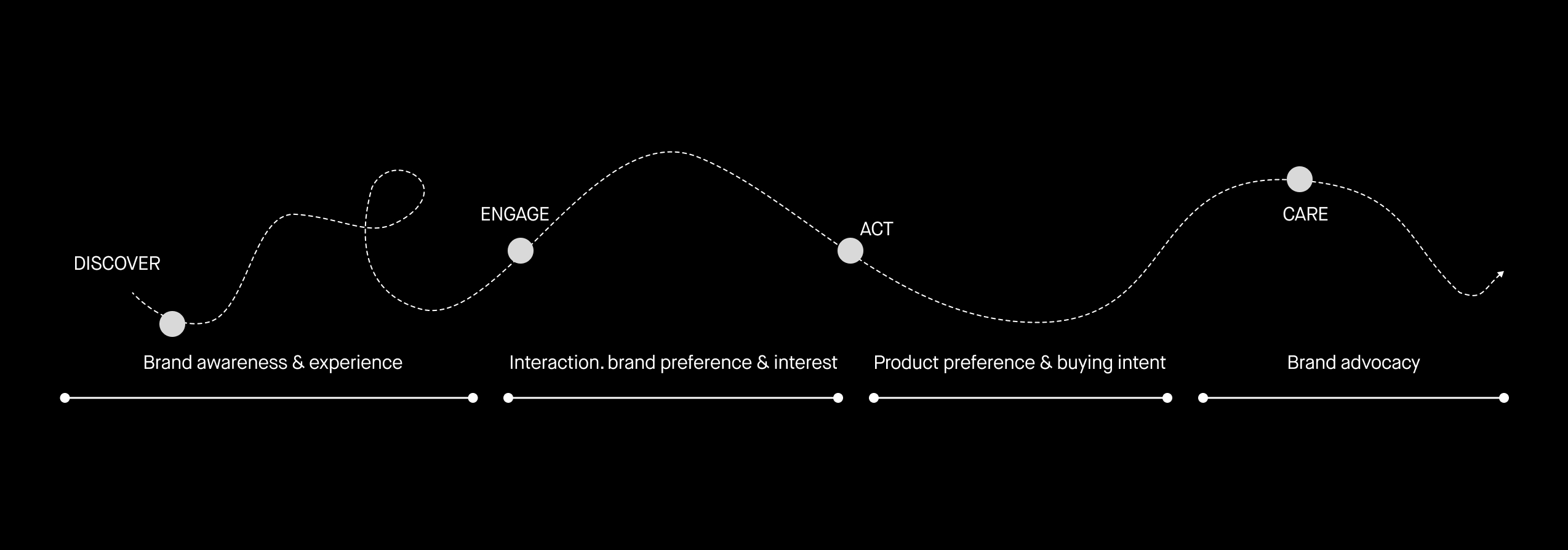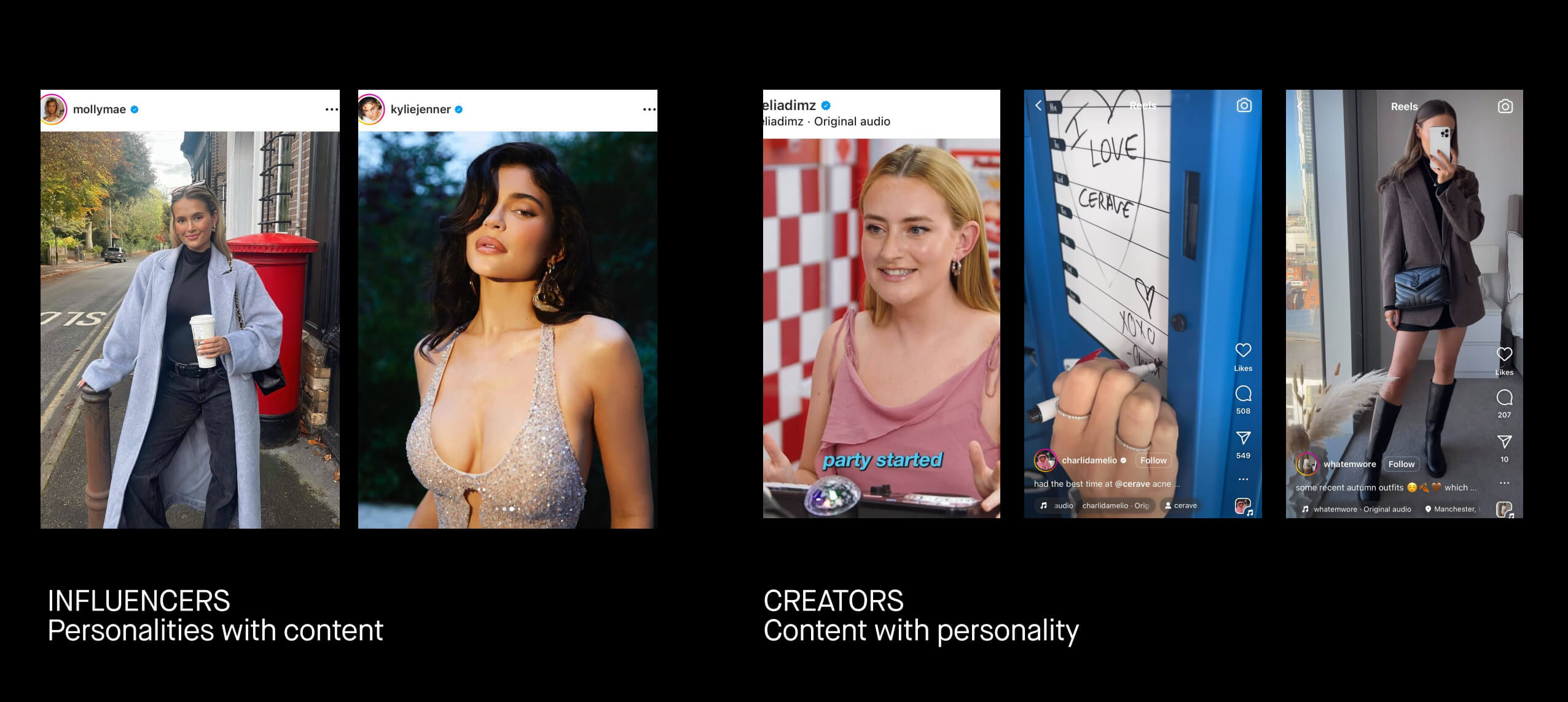What’s next: Influencer marketing in 2025

What’s next in influencer marketing is not just a tactical change. It’s the evolution of influencers’ role, the shifting balance towards creators, and the decisive impact of AI.
Altogether, this makes the currency of influence a major marketing investment: 76% of C-suite respondents report growing budgets for their influencer programs in 2025 as brands strive to build more and more sophisticated influencer marketing strategies.
To help you stand out in a sea of influencer campaigns, we’ve identified six influencer marketing trends that will dominate 2025.

Diversification of objectives and full-funnel influencer marketing
There will be a shift of priorities and the understanding of influencer marketing as a valuable touchpoint across the full user experience.
We can already see its start, even though some marketers still value brand awareness over lower-funnel objectives.
But the ability of influencer marketing to drive conversion and loyalty will result in a much higher level of full-funnel activation, especially for brands that understand that influence marketing is not just a broadcast. It’s a sales lever.
According to recent research, as much as 78% of TikTok shoppers discover products through influencers.
To tap into the power of TikTok Shop’s influencer engine for Walkers, we created the Temp Drop Shop in partnership with PepsiCo’s in-house agency Sip & Bites. The Temp Drop Shop put a Flamin’ Hot twist on the classic British corner store both IRL and online, via an influencer campaign featuring some of the UK’s favorite TikTok stars as they nabbed some limited-release spicy snacks.

More TikTok?
Learn what makes TikTok’s “brainrot” content so unique and how it has evolved to reflect the cultural zeitgeist of Gen Z.
Diversification of income through more products and platforms
We expect influencer marketing to move from an Instagram monopoly to a more diverse platform use and monetization options.
It might be TikTok due to its high number of users, engagement, and content volume. However, just in the last year and a half, a variety of platforms have released 10 different ways for creators to monetize and test their content and increase their reach:
- Meta ads expansion on Reels
- Reels monetization including music
- Facebook performance bonuses expansion
- Facebook stars’ revenue expansion
Instagram Creator Marketplace - TikTok Series
- TikTok Creativity Program Beta
- TikTok Affiliate
- TikTok Creative Challenge
- Snap Spotlight rewards
This indicates a fight for getting the highest share of creators across the different platforms. Creators will flock to where they can best reach their audience, so no platform is safe.
As a result, more influencers are expanding their reach to different channels and platforms. Some of the most popular ones are Substack and YouTube Shorts, which have reported consistent YOY growth since 2021.
And then, of course, there’s podcasting. With seemingly every influencer starting one, there are now over 6 million podcasts in the world. While the proliferation of podcasts may make them seem like a trend that’s reached its threshold, the number of podcast listeners worldwide continues to grow, with 546.7 million reported at the end of 2024.
The disparity between influencers and creators increases
In 2023, the majority of the influencers surveyed by CreatorIQ defined themselves as content creators or used the words “creator” and “influencer” interchangeably, while only 6% preferred to be called just influencers.
Now, however, the terms “creator” and “influencer” are becoming more disparate, with each group offering a set of distinct advantages to brands.
Influencers are best thought of as “personalities with content.” These are the Molly Maes and Kylie Jenners of the world, big names that are oftentimes celebrities in their own right. As a result, influencers have shown their strength to be in generating brand awareness.
Creators, by comparison, are “content with personality.” These are the Amelia Dimoldenbergs and Sean Evanses. They’re people who are known less for who they are and more for what they do: Amelia as the host of Chicken Shop Date and Sean as the host of Hot Ones.
For creators, their strength lies in their ability to generate conversions. Essentially, consumers watching creator content are more likely to complete a purchase from a brand partner or sponsor than consumers following an influencer.

Unified and more holistic measurement approaches
A continued focus on the measurement will catalyze the development of more sophisticated reporting methods.
Currently, brands are using a fragmented approach where the KPIs aren’t necessarily clear and are different across all organizations and brands. But in 2025, we expect this measurement puzzle to shift to a unified measurement strategy.
There will be actionable ways to measure activity at each stage of the funnel, with a focus on value over vanity. We see it as:
- No ‘one size fits all’ KPI
- Looking at value metrics like EMV or value per pound
- Valuing resonance over reach
Using MarTech to determine incrementality - Having a clear business goal to ladder up to
AI-driven process
AI has already begun to play a role in streamlining the process behind influencer campaigns and, in 2025, that role will continue to evolve. However, the role of AI in influencer marketing will never go beyond that of support staff. Fundamentally, influencer marketing is about human relationships.
At the moment, one of the most time-intensive parts of influencer marketing is influencer discovery and vetting. AI makes these processes much faster using such functions like:
- Image and video recognition
- Audience segmentation and profiling
- Performance analysis and learnings
Automated brand safety analysis - Brand suitability analysis and matching
By evaluating what the influencers’ content looks like and whether they have worked with your competitors in the past, AI also helps source influencers that can match all of your specific requests.
Staying on trend with the power of influence
In 2025, influencer marketing will become a continuous narrative that shapes the future of your brand. By continuing to evolve your approach, you’ll be able to adapt to the changes smoothly and leverage the power of influence to the fullest.




